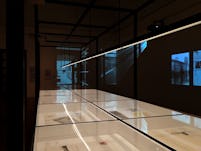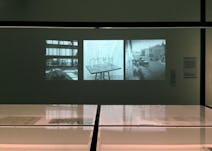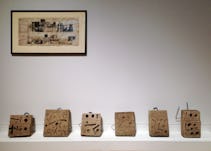New Brutalist Image | Tate Britain: London, UK
exhibition design



New Brutalist Image 1949–55 was co-curated by Victoria Walsh and Claire Zimmerman, and was on display at the Tate Britain in London UK from November 24, 2014 through October 4, 2015.
In 1953 the sculptor Eduardo Paolozzi, the artist-photographer Nigel Henderson, and the architects Alison and Peter Smithson joined up with the pioneering structural engineer Ronald Jenkins to create the radical and still highly influential exhibition Parallel of Life and Art. This historic collaboration was first forged during the design and building of the architecturally important Hunstanton School in Norfolk which was conceived by the Smithsons in 1949. Capturing the time and process of the building of Hunstanton, this exhibition brings together an extensive range of previously unseen photographs by Henderson, engineering milestones by Jenkins, drawings and proposals by the Smithsons, and sculptures by Paolozzi.
Curated with direct reference to the innovative design and commissioning process of Jenkins’s office at Ove Arup & Partners in 1951, the exhibition highlights how this office project became the test-bed of ideas for the group’s design and installation of Parallel of Life and Art which underpinned the movement that the critic Reyner Banham and others would famously label ‘New Brutalism’ in the early 1950s.
RVTR collaborated with Zimmerman and her team to develop a spatial strategy for the exhibit of a range of physical artifacts comprising the work of the group, and designed the exhibit frame which houses these artifacts, support video projections and illuminate the works. The central challenge of the exhibition design was how to bring together a heterogeneous set of artifacts produced in a range of media: drawings, photographs, printed matter, sculpture, collage, cabinetry, and project content. This was both a conceptual and practical challenge, from issues of lighting and power delivery to that of the overall visual order. The frame brings together these disparate visual phenomena into relation with one another, articulating the common approach to visual literacy that underpinned the efforts of the Independent Group. The frame builds on the historical legacy of other framing operations – from the CIAM Grille, to the expressed structure of the Hunstanton School, the camera as framing device, the Jenkins office at Arup or the ICA gallery. The frame provides order, transforming entropic disorder into productive heterogeneity.
New Brutalist Image 1949–55 was curated by Victoria Walsh and Claire Zimmerman, assisted by Helen Little, Elena Crippa, and Ricky Bowtell . Spatial planning and display framework design: RVTR; Structural and Lighting: Arup; Display framework: fabrication and installation by Nick Westby, Westby and Jones, Ltd.
This project was made possible with generous support from Arup and The University of Michigan (College of Literature, Science and the Arts, and Taubman College of Architecture and Urban Planning).
| Typology | Exhibition Design |
| date | 2014-2015 |
| location | Tate Britain, London, UK |
| scope | Exhibition Design |
Team
| Curators | Victoria Walsh and Claire Zimmerman, assisted by Helen Little, Elena Crippa, and Ricky Bowtell |
| Spatial Planning and Display Framework Design | RVTR: Geoffrey Thün and Dan McTavish |
| Structural and Lighting | Arup |
| Display Framework | Fabrication and Installation by Nick Westby, Westby and Jones, Ltd. |